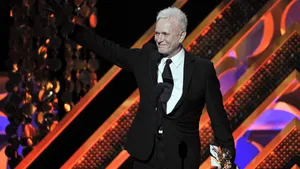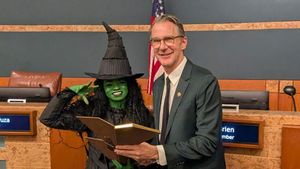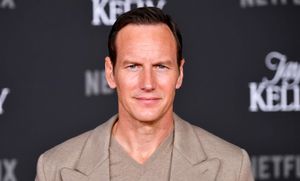Justin Ángel Knighten doesn’t fit the archetype of a federal bureaucrat. At 39, he is a gay Latino man and the grandson of Mexican immigrants, overseeing external affairs at the Federal Emergency Management Agency, a department whose mission often reads like a litany of worst-case scenarios. Yet Knighten’s approach is one of grounded optimism, a rare trait in Washington, D.C. His job isn’t just about managing crises—it’s about ensuring that FEMA reaches the people who need it most, often during the worst moments of their lives.
Keep up with the latest in LGBTQ+ news and politics. Sign up for The Advocate's email newsletter.
The interview takes place in FEMA’s National Response Coordination Center, the sprawling hub of federal disaster response operations at the agency’s D.C. headquarters. On the walls, massive monitors display maps, weather forecasts, and real-time data from across the country. Dozens of rows of computer workstations sit ready for activation, each of the 200 or so stations representing a different federal agency or team that convenes during a disaster. But today, the room is tranquil—a rare “blue skies” day in a job where calm is often fleeting.
Knighten sits at a conference room table, his demeanor warm but purposeful. His laugh is quick, his tone thoughtful, even when discussing the weight of his work. There’s no denying the seriousness of his role, but he carries it lightly, punctuating his insights with humor. “We are laughing all day,” he said. “We always say, if we’re not laughing, we’re crying.” It’s more than a coping mechanism—it’s a way to build resilience. “If it’s happening to me, it’s definitely happening to my team,” he added, recalling the emotional toll of the Maui wildfires. “So we’ve got to keep it lighter. It’s the only way we’re going to get through.”
 Courtesy Justin Knighten
Courtesy Justin Knighten
Knighten’s work is personal. Growing up in Northern California, he experienced firsthand the terror and displacement that disasters can bring. “Everything my mom had done to build a life for me and my brother could have gone away,” he recalled of his childhood in a flood-prone community. He spent days filling sandbags with his family, knowing their efforts might not be enough.
When the floodwaters came, Knighten and his family were forced to evacuate. “Luckily, we did that in advance,” he said. “But I remember being afraid for days because I hadn’t been home. I stayed with family members across town, just thinking, ‘Do I even have a home to go to?’ My whole life was going to change. And not only my life but my entire community.”
A Presidential visit
In 1995, a young Knighten watched President Bill Clinton visit the area after devastating floods. Clinton walked the muddy streets with FEMA officials to reassure residents. “Little did I know, right down the street from where I grew up, President Clinton actually visited with FEMA,” Knighten said. At the time, the moment barely registered. It wasn’t until years later, after joining FEMA, that he recognized its significance. “We do those things now—disaster tours with the president, showing up to see the impacts firsthand,” he said. For Knighten, those visits are about more than optics; they show people that their government is paying attention.
Knighten’s path to FEMA began in California, where he worked in Gov. Gavin Newsom’s administration during a particularly volatile period. His first exposure to emergency management came during the state’s devastating wildfires. “I wasn’t really sure what emergency management meant at first,” Knighten said. “But on my first day, I realized that every issue I care about—every community I’ve fought for—was either going to go away or survive depending on how we handled catastrophic events.”
It was a transformative moment. “It was like a light switch went on,” he said. “My whole worldview changed. I became fully committed to this work because it impacts everybody.”
 Courtesy Justin Knighten
Courtesy Justin Knighten
Life in a disaster movie
Knighten’s time in California prepared him for the challenges he’d face on a national scale at FEMA. Yet even with his experience, some disasters feel surreal. “One of my mentors texted me during a response and said, ‘How’s life in a disaster movie?’” Knighten recounted. “It took me back because, at that moment, it felt like something out of Hollywood.”
Hurricanes Helene and Milton were two such moments. The back-to-back storms devastated parts of Florida and the Carolinas, leaving destruction in their wake and misinformation in their aftermath. Social media became a breeding ground for false claims about FEMA’s relief efforts, creating confusion and, in some cases, danger.
“We were seeing firsthand accounts of people making the wrong decisions because of misinformation,” Knighten said. The falsehoods ranged from scams about relief payments to misleading evacuation advice. In some cases, he said, these lies were traced to foreign actors, including Russia and China, who used the disasters to sow distrust in the U.S. government. “It’s not new, but it’s escalating,” Knighten said. FEMA countered with targeted messaging campaigns, leaning on local leaders and influencers to disseminate accurate information. “You have to meet people where they are,” he explained. “It’s not enough to rely on traditional channels.”
FEMA, alongside other federal agencies, worked to counter the lies, relying on local partnerships and grassroots organizations to deliver accurate information. “You have to be in different places and spaces to get a message to resonate,” Knighten said, explaining how his team adapted its strategies to reach the people who needed them most.
A different approach
Knighten’s tenure at FEMA has coincided with a dramatic shift in the agency’s approach, driven by Administrator Deanne Criswell. He said that her directive to “prioritize people and meet them where they are” has reshaped FEMA’s messaging, strategy, and, in some cases, identity. Knighten said he turned that philosophy into action, crafting campaigns to reach communities often overlooked in disaster response.
Under his leadership, FEMA launched guides tailored to older adults, caregivers, and rural populations. The “Ready” campaign, a long-running public education initiative, was revamped to reflect the needs of Latino and Black communities. FEMA also developed its first-ever strategy for tribal nations, which Knighten described as a landmark achievement. The plan included appointing the agency’s first National Tribal Advocate and working directly with Native leaders to address disaster preparedness and recovery gaps. “This was a big deal,” Knighten said, reflecting on a feast day he attended in New Mexico as part of FEMA’s outreach efforts.
 Courtesy Justin Knighten
Courtesy Justin Knighten
Knighten believes his identity as a gay man has uniquely prepared him for the pressures of emergency management. “Being gay definitely helps,” he said, reflecting on how adversity in his personal life has shaped his professional resilience. “All the shit that you experience teaches you how to be resilient, how to absorb a lot of energy—especially bad energy—and work through it. It’s given me the ability to be more effective by putting myself in other people’s shoes.”
The community contributes
Knighten views the LGBTQ+ community as uniquely equipped to understand and connect with diverse populations, which he sees as an asset in his work. “We’re young, we’re old, we’re wealthy, we’re poor, we have disabilities, we don’t have disabilities,” he said. “We were the class nerd, the college athlete, the cheerleader, and everyone in between. Being part of a community made up of so many different experiences gives you a better sense of the ‘other’—empathy for people whose experiences aren’t your own.”
As the Biden-Harris administration nears its end, Knighten prepares to leave FEMA. His departure comes at a time of uncertainty for the agency. Proposals, like the Republican Project 2025 plan to replace career officials with political appointees, have raised concerns about FEMA’s ability to maintain its people-first approach. “I can’t imagine anyone coming into my job or other jobs here as an appointee wanting to do that given the talent and the caliber of this workforce,” Knighten said. Despite the challenges ahead, he remains optimistic about FEMA’s future. “What this agency does for people every day… the only option is to continue to support and grow.”
 Courtesy Justin Knighten
Courtesy Justin Knighten
This includes personal growth. Recently, Knighten began pursuing a certificate in world art history through the Smithsonian Associates program. The coursework, he joked, is a welcome escape. “It’s me and a bunch of amazing 80-year-olds,” he said, laughing. “It’s such a great way to decompress, to just think about something completely different for a little while.”
Cooking, for him, is another way to decompress and reconnect with his roots, and one dish in particular—pozole—has become a source of pride. “When I was 21, I had my grandmother walk me through her pozole recipe,” he said. Over the years, he refined it, and last year, he made a batch for his mother. Her reaction was priceless: “This is so much better than your grandmother’s.”
For Knighten, that moment was a small but significant triumph. “Success professionally, she’s like, ‘Okay, Miho, whatever.’ But with the pozole, she’s like, ‘Oh my God, I’m impressed.’”
It’s a sentiment that mirrors his work at FEMA: a relentless focus on getting it right, not for accolades but for the people who depend on it. As Knighten reflects on his time at the agency, he returns to the philosophy that has guided him. “It’s about more than just aid,” he said. “It’s about reminding people that they’re not alone.”


 Courtesy Justin Knighten
Courtesy Justin Knighten Courtesy Justin Knighten
Courtesy Justin Knighten Courtesy Justin Knighten
Courtesy Justin Knighten Courtesy Justin Knighten
Courtesy Justin Knighten


































































Charlie Kirk DID say stoning gay people was the 'perfect law' — and these other heinous quotes